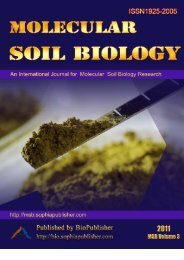Molecular Plant Breeding (online), 2011, Vol. 2 http://mpb ...
Molecular Plant Breeding (online), 2011, Vol. 2 http://mpb ...
Molecular Plant Breeding (online), 2011, Vol. 2 http://mpb ...
- No tags were found...
Create successful ePaper yourself
Turn your PDF publications into a flip-book with our unique Google optimized e-Paper software.
<strong>Molecular</strong> <strong>Plant</strong> <strong>Breeding</strong> <strong>2011</strong>, <strong>Vol</strong>.2, No.8, 48-59<strong>http</strong>://<strong>mpb</strong>.sophiapublisher.com1.3 Stability of transgene expression in crossingtransmissionDuring the course of crossbreeding for generatingdifferent transgenic hybrid rice lines, all the hybridswere subject to Basta-resistance assay and only theresistant plants were selected. These ensured theexistence and expression of selected bar gene in allhybrids. What about the fate of the non-selectedcecropin B gene? The completeness of cecropin Bgene expression cassette in hybrid rice lines wasexamined by Southern blotting analyses and theexpression status of cecropin B in crossingtransmission was revealed by Northern blottinganalyses.To detect the completeness of cecropin B geneexpression cassette in rice genome, Southern blot wasconducted after genomic DNA was digested with PstⅠand HindⅢ, which released a 1.12 kb fragmentcomprising of the coding region of cecropin B geneand its pin terminator (Figure 3). Results showed thatpresence of the predicted 1.12 kb fragment in hybridlines mainly depended on their original transgenicdonors (Figure 1C and 2C). Transgene donor TR 5,TR 6 and their derived hybrids did not exhibit theexpected 1.12 kb fragment, illustrating there was nointact cecropin B copies, or more probably, the cutsites of restriction enzymes (Pst Ⅰ and Hind Ⅲ) incecropin B gene expression cassette were modified.Transgene donor Ming B, Jingyin 119 and theirhybrids generated the 1.12 kb fragment as expected,revealing that there was at least one intact copy ofcecropin B gene in these transgenic lines.Northern blot results showed the expression behaviourof non-selected cecropin B gene varied significantlyamong transgenic donors and their hybrid lines(Figure 1D and Figure 2D). The expression ofcecropin B gene in the primary transformants (T0generation) of all the four transgene donors includingTR 5, Ming B, TR 6 and Jingyin 119 was proved byNorthern blot analysis (data not shown). However, intheir self-pollinated offspring, gene silence ofcecrropin B occurred in TR 5 and Ming B donor(Figure 1D), both harbouring 3 hybridization bands ofcecropin B (Figure 1B). The TR 6 and Jingyin 119donors, with 5 and 2 hybridization bands of cecropinB gene respectively (Figure 1B and 2B), expressedcecropin B gene stably arcoss 6 and 12 generations,respectively. This indicated that silencing ofnon-selected cecropin B over generations was relevantto different transformation events rather than thenumber of integrated hybridization bands. In view ofthe Southern blot results, we also concluded that therewas no certain relationship between the cecropin Bgene expression status and the emergence of theexpected 1.12 kb fragment, which was used to predictthe completeness of cecropin B gene copy.The expression behaviour of cecropin B gene in crosstransmission was revealed by comparing the Northernblot results of transgenic hybrids with that of theircorresponding donors. Gene silence of cecropin Boccurred in both self-pollinated progeny of TR 5donor (T5) and all its derived hybrid lines (F 3 ) (Figure1D). In TR 6 transgene donor, cecropin B gene wasexpressed at mRNA level over 6 generations, butsilenced in its two hybrid lines (F 3 generation).Interestingly, cecropin B gene did not express in theselfed progenies (T6) of transgene donor Ming B, butexpressed in its two out of three cross lines MingB/Jia 59 and Ming B/Xuzao, till F3 generation (Figure1D). The stable expression of cecropin B gene wasobserved in Jinyin 119 donor and all its hybrids,ignoring the complex cross combinations and multiplecross turns. We analysed the cecropin B expression inthe progeny plants of 14 out of 17 hybrids fromJingyin 119 donor (Figure 2D). Whether transgnenedonor Jinyin 119 was female parent or male parent(C20 / Jingyin 119), whether transgenes in Jingyin 119were transferred through one cross turn (Jingyin119/57, Jingyin 119/Bing 94-02, Jingyin 119/59), twocross turns (Jingyin 119/59//L97-55, Jingyin 119/57//9522, Jingyin 119/390//S1, Jingyin 119/63//T951,Jingyin 119/Bing 94-02//T951, Jingyin 119/02//T951,Jingyin 119/63//390, Jingyin 119/59//DS4 and Jingyin119/503//T951) or three cross turns (Jingyin 119/ 57 //DS4///L97-55), or stacked by crossing betweentransgenic hybrids (Jingyin 119/59//DS4///Jingyin119/31//9522), the non-selected cecropin B geneexpressed stably in all hybrids over 6 to 8 generations.In general, the expression behaviour of non-selectedcecropin B gene was complex in crossbreeding52






